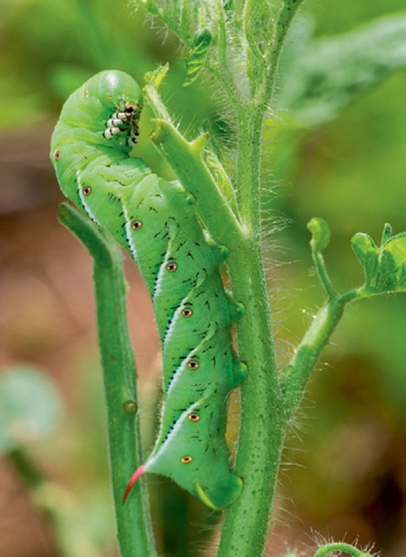What’s Eating My Tomatoes?
What to do when you discover critters have been feasting on your vegetables before you get to them.
It looks like ants ate a hole in my tomato! And something’s chewing up the leaves of my zucchini.
I doubt that ants ate a hole in your tomato. Most likely, another creature (probably a hornworm) ate a hole in the tomato, and now the ants are enjoying eating from the hole that other creature made. Since the first creature that made the hole damaged or removed the protective skin, smaller creatures like ants now have easier access to the sugars of the tomato.
Keep a lookout for signs of worm damage on leaves, flowers and fruit. If you notice something eating your tomato or zucchini plants, there are a couple steps you can take:
- Remove big worms by hand.
- If you notice small worms (usually under leaves or within curled leaves), cut off leaves or parts of the plant that are affected.
- Spray with organic pesticide Bt (Bacillus thuringiensis).
Also, when watering both tomatoes and zucchini, it’s best to use a drip irrigation system without overhead watering. If you’re using a hose, water the soil and avoid getting water on the leaves. This will reduce unwanted diseases, pests, mold, bacteria and fungi.
Regularly examine tomato plants closely to see if there is damage being done by caterpillars. Look for folded-over, eaten or missing leaves. As your gardening experience increases, these observations will come easier. Always remove a caterpillar by hand and destroy or relocate it when you discover it.
As a general rule for dealing with any pests creating problems in your garden, start with manual methods of control. Rub off pests by hand, remove affected leaves (or parts of plants), or spray off pests with a hose sprayer. Most garden pests never become a problem if they’re caught early and dealt with before they get beyond control.
In our experience, the most noxious veggie garden pests in South Florida are caterpillars, aphids, whitefly, snails and leafminers. We use Bt for caterpillars and other foliage-feeding worms. The agent is a bacterium that infects the pests and kills them. This can be sprayed weekly on plants such as tomatoes, eggplant and mustards. Spraying in the early morning or late evening is best as it evaporates quickly. For aphids and whitefly, we use an organic pesticide called M-Pede. It is specially designed to kill softbodied insects, but you must spray it directly on the pest. It will not work preventatively like the Bt. Usually whitefly and aphids reside on the undersides of leaves and in the center of the growing tips, so that’s where you should focus the spraying. For whitefly, which will be on peppers and tomatoes, spray in the early evening or early morning when they’re less active and hanging on the leaves.
For snails, we use an easily obtained bait called Sluggo that you sprinkle around the garden. If a snail or slug problem arises, organic snail baits are usually easy to find at amazon.com, Home Depot or gardening stores.
I’m getting a late start on my backyard garden. What can I plant now? And what can I plant in the springtime that can grow when it gets warmer?
It isn’t too late to get in a good season of cool-weather veggies and herbs. Sometimes September or October can be too early to plant cool-weather crops because there’s still a significant threat of extreme heat and hard rain. Planting in November, December or January is a safer time with less risk of failure. It’s a good time to plant most herbs, leafy greens, fruiting veggies like tomatoes, peppers, beans and eggplant, and root veggies like carrots, radish and turnips.
In the spring when it gets warmer, try melons, cucumbers, sweet potato and other tropical/heat-tolerant veggies and herbs. Many cool-weather plants can grow through spring and sometimes through summer if established and healthy.
In the warm season, plant cover crops to enrich the soil and suppress weeds in the veggie gardens, and focus on tropical fruit trees and heat-tolerant perennial greens (katuk, cranberry hibiscus, Okinawa spinach, callaloo) outside of the main veggie garden area.
Have an edible gardening question? Email Dylan at <garden (AT) ediblesouthflorida (DOT) com>.





